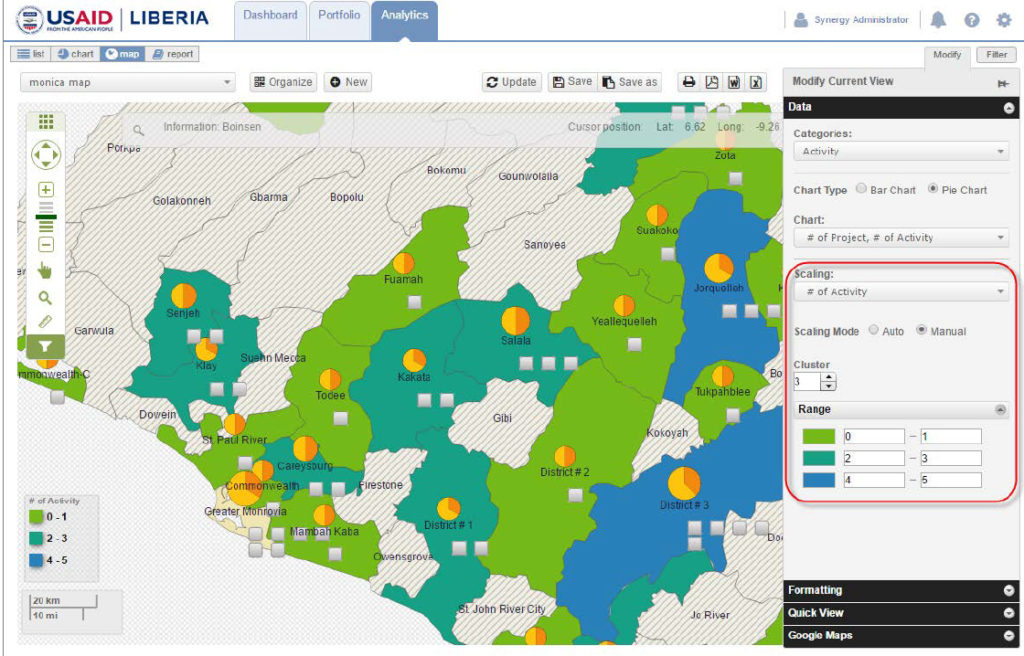Within USAID’s Liberia Strategic Analysis (LSA) Project, under subcontract to Social Impact, Synergy International Systems has improved the quality of data collection and analysis for USAID/Liberia’s country wide development response efforts.
PIDS is the first online data monitoring system for USAID/Liberia, automating the annual performance review and informing Mission-level decision making.
Prior to LSA’s 2015 launch, the legacy data collection system had been deployed, but had not yet achieved comprehensive data collection. It served as a data repository but did not allow for any built-in data analysis. Since launching the upgraded PIDS in 2016, the system has allowed for Mission users to achieve 100% data collection from Implementation Partners (IPs) and has fully automated the Mission’s annual Performance Plan and Report (PPR).

How PIDS Works
Since 2015, Synergy has been adapting PIDS to accommodate USAID’s requirements for information availability, portfolio management, performance monitoring and evaluation, and decision-making. Synergy rolled out PIDS in 2016 and has been training users and providing ongoing technical support ever since. Having implemented the system early in the project, LSA was able to shift its focus to data collection and data quality in later years of the five-year project.
Synergy staff assisted IPs with their data entry for target and actual project data and generated offline data entry sheets for partners who required manual data uploads into the system. This was especially helpful for partners with limited internet bandwidth or accessibility. A mobile version of PIDS, e-PIDS, was also developed for real-time data collection.
e-PIDS was the first mobile app ever created for a USAID Mission to be used for performance data collection and analysis. e-PIDS has been a crucial tool for the mission during the COVID-19 crisis. It has allowed for data on ongoing activities to still be uploaded to PIDS, even though site visits are limited due to travel restrictions. For example, an IP working in the forestry sector in Liberia relies heavily on ePIDS to continue site visits and data entry in isolated forest areas. e-PIDS allows on-site staff to still upload data to PIDS and keep activities moving forward. In addition to the key aspects of e-PIDS for COVID-19 response, e-PIDS has allowed for time optimization of all site visits. Prior to the development of e-PIDS, staff would collect data by hand and on paper, often in very remote areas of Liberia. Staff would then have to manually enter data when they returned to the Mission. Now, because e-PIDS can operate offline, staff can enter all their site visit data while in the field, no matter how remote the site visit is. COVID-19 has drastically accelerated both the use and the importance of e-PIDS. This has allowed for real-time analysis of ongoing activities, despite the pandemic.
PIDS Results
For the first time in 2017, PIDS provided 100% of the development data required to complete the annual USAID/Liberia PPR. This report details the progress towards development objectives. PIDS has continued to provide 100% of the data for PPRs in subsequent years.
PIDS currently tracks 150 performance indicators related to malaria response, 25 related to education response, 60 related to democracy and governance, and many more. PIDS provides USAID staff with monitoring visualizations on which implementing partners are receiving funds, and which interventions are being carried out. All data on these performance indicators are analyzed to measure progress towards national development objectives.
With just one click, USAID technical teams can now generate PPR indicators data for all development objectives. This was achieved by making improvements to the PIDS reporting tools to produce analytical reports that would substantially reduce the time spent by the Mission on the annual PPR. In addition, LSA provided weekly indicator tables throughout the PPR process, as well as ongoing reviews and updates from the PIDS. Through utilization of the PIDS, USAID has improved the accuracy and completeness of reporting data. The built-in analytics enable “drag-and-drop” functionality to make custom tables, dashboards, GIS maps, and other reports. None of these reports require any coding or technical proficiency, providing a user-friendly interface for non-technical users. This has facilitated a Mission-wide shift away from excel-based data storage, to an automated, data analytics platform that informs decision making and supports program learning.
PIDS has enabled the USAID/Liberia mission to improve data-driven decision-making through two key developments.
- Each USAID/Liberia development objective is measurable, thus determining how they were contributing to the Country Development Coordination Strategy (CDCS) for Liberia for 2013-2019. This helps the mission shape their ongoing efforts to achieve country-wide development goals. PIDS data was essential in creating the Liberia CDCS for 2019-2024. Without PIDS, measurement of progress towards goals would be inefficient and potentially inaccurate. Practically, this means USAID/Liberia can analyze the effectiveness of programs as they are being implemented, and it helps the mission determine how to shift the goals of the program during mid-course evaluations.
- e-PIDS, the PIDS mobile app, allows for real time data collection thus enabling significant efficiency gains towards development objective measurement.
But how exactly does PIDS impact decision-making?
PIDS helps USAID/Liberia with strategic decision-making through access to live, high-quality results and indicator data about Mission programs. Part of this process involves evaluations of ongoing programs to determine if they are being effective, meeting their stated goals, and instigating midcourse corrections/project re-designs if necessary. The only way to have a scientific approach to these evaluations is by being grounded in project data.
Thus, all evaluations start with an analysis of project and program data in PIDS. Evaluators use this data to understand how the activity is progressing prior to the evaluation, which can be helpful if any mid-course corrections are needed. In total, 26 activities have been improved through a PIDS data-driven approach to evaluations, leading to a faster response cycle to the needs of the country, and a more productive relationship between USAID/Liberia and the relevant government ministries.
PIDS started as an effort to bring data analysis capabilities to an online data repository and move away from paper and excel-based data storage. This initially transformed the PPR process, which was all done manually prior to PIDS. It evolved to encompass an offline and mobile app, e-PIDS, which has led to significant time optimization of site visits and has been crucial for the Mission since the onset of COVID-19. Finally, PIDS has effectively reached its goal of helping Mission decision-making by creating an effective cycle of project data entry, Mission data analysis, program data evaluation, learning, and the creation and re-design of new programs, moving the Mission towards significant progress on development objectives.
LSA concluded in early 2021, and Synergy (under a direct contract with USAID/Liberia) is currently adapting PIDS, creating additional evaluation features, and providing technical support to ensure long-term sustainability of the system. Eventually, PIDS will be integrated and transitioned to the DIS, USAID’s upcoming agency-wide M&E system for data-driven decision making.
Disclaimer: This article is made possible by the support of the American People through the United States Agency for International Development (USAID). The contents of this publication are the sole responsibility of the publisher and do not necessarily reflect the views of USAID or the United States Government.


